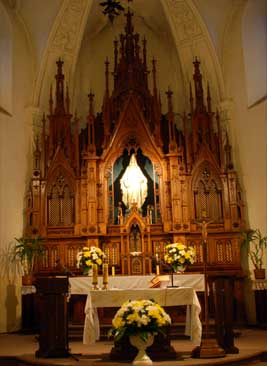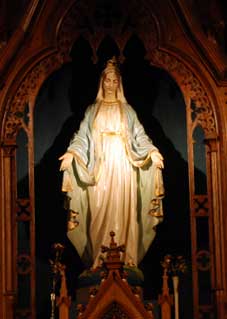
The church was built in a Gothic style of stone, brick, and part of the pedestal from boulders. Its peculiarity is the asymmetrical division of the interior into two aisles. The original Gothic body of the church has survived to this day without any significant changes. Only its characteristic slimness was lost by the ground constantly rising around the church. The evidence are four-level stairs leading down to the lower aisle and the side entrance with the historic Gothic portal bricked up many years ago, which is located in the northern wall of the building.
The greatest changes in the appearance and the interior of the church took place in the 16th and 17th centuries. The Bridgettines carried out a number of thorough works aiming the expansion of the monastery and the church.
During the reign of the abbess Agnieszka Jastkowska (1589-1630), the expansion of the monastery started with creating three of the later four wings. The tower and a church choir were built. The chancel was given a semicircular closure, and a special room was added to it between the northern chapel and the sacristy. Another abbess - Dorota Firlejówna (1632-1660) focused primarily on changing the interior decoration of the church and the important monastic rooms. In her time the choir stalls were inserted in the chancel and five altars were also created: the main altar, with the image of the Assumption of the Blessed Virgin Mary and of Saint Sophia and Barbara in the side chapel. In addition, two side altars: one with an image of the shepherds' homage, the other with the image of Jesus Crucified. The altar of St. Bridget was placed in the side aisle. At that time a new ambo and balustrades decorated with emblematic images appeared.
When in the year 1853 the Visitandines took place the Bridgettines', nothing but the stalls left inside the church. The Sisters brought their own altars and an ambo. In the main altar the image of the Sacred Heart of Jesus was inserted.
The current decor of the church is the result of many renovations and architectural works. All walls and ceilings of the church have been maintained for years in a uniform white color, which best symbolizes the purity of its Saint patron, the Blessed Virgin Mary. On both sides of the main aisle, there are rows of historic, bas-reliefed and covered with 17th-century paintings benches and some newer origin kneelers and chairs. On the walls, there are also paintings of the Lord Jesus, surrounded by His disciples, St. Maximilian Maria Kolbe on the background of the concentration camp's wires and in front of the ambo - St. Anthony, whose cult is also associated with this church.
 In the chancel there is a neo-Gothic Great Altar. Openwork, intricately carved and brightened-up with gold platings altar presents impressively and constitutes a decent background, yet a huge frame for a central figure of the Mother of God, placed in its central part. Its shape resembles the front of a richly decorated Gothic temple, and with a silhouette of Mary on a dark sapphire background forms a huge portal.
In the chancel there is a neo-Gothic Great Altar. Openwork, intricately carved and brightened-up with gold platings altar presents impressively and constitutes a decent background, yet a huge frame for a central figure of the Mother of God, placed in its central part. Its shape resembles the front of a richly decorated Gothic temple, and with a silhouette of Mary on a dark sapphire background forms a huge portal.
The figure of the Blessed Virgin Mary in the golden crown, smashing by Her feet the head of the serpent, is meant to symbolize the victory of the Mother of God over the evil of this world. It replaces the image of the Assumption of the Blessed Virgin Mary located here in the days of the Bridgettines and the painting of the Sacred Heart of Jesus hunging there in the days of the Visitandines.
Many of the historic 17th-century paintings that have survived to our times are worth to be noticed: on the south wall of the chancel the Assumption of the Blessed Virgin Mary (canvas), the Annunciation of the Blessed Virgin Mary (plank) and on the north wall an image of St. Francis de Sales (canvas) and St. Joseph (canvas). The gothic painting of St. Bridget of the 15th century painted on a wooden plank is placed in the main altar.
We invite you to familiarize yourself with the hymn of the Church of the Assumption of the Blessed Virgin Mary the Victorious
HYMN
- O Mary, raised into heaven,
Beyond angelic choirs exalted;
The Lord's worshipped Your soul and flesh,
Has taken to heaven and graced with glory.
There you receive homages and honors,
The Lord gave you the throne.
The most beautiful visions' delight You know,
Surrounded by the wreath of Your servants.
- You have already gone to heaven, dear Mother,
You left the earthly valley of tears,
Lead us straight to God,
Ask Him to remove all our guilt.
Give us, Mother, to lead our life in chastity,
May the heart be blessed with heavenly scent.
Multiply our faith, teach us love,
Take care of us and protect from misery.
- O Mary, the Queen of the world,
Recall Your Son's word today,
That on the cross He called You Mother
Our mother before He took You back.
So we believe, the orphaned children,
That you'll keep what God has promised us,
That, when our souls will fly away from the flesh,
It means we'll be at Your feet forever






